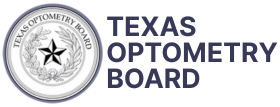Please note that improper advertising, including the improper form of professional identification, can result in disciplinary action, including substantial fines.
Board Certifications
The Texas Optometry Board does NOT certify optometrists. Therefore it is misleading for a doctor to state that he or she is certified by the Optometry Board. The Board licenses therapeutic optometry license and optometric glaucoma specialists.
Board Certification by readily identifiable organizations is a voluntary procedure available to optometrists. Optometrists certified by readily identifiable organizations may advertise that they are certified provided the same advertisement specifically identifies the organization that awarded the certification or specialization.
- Example: Joe Smith, O.D., FNAEI / Fellow of the North American Eye Institute Advertising Specialization
Optometrists that have qualified for a specialization designation by a readily identifiable organization may advertise such provided the same advertisement specifically identifies the organization that awarded the specialization designation.
- Example: Janet Smith, O.D., Contact Lens Specialist / Certified by the North American Contact Lens Foundation
Noting a certification and/or specialization applies to all types of advertising including, but not limited to, business cards, prescription forms, door signs, internet postings, and telephone book listings.
An optometrist may advertise that he or she specializes in a certain type of treatment or patient.
See Board Rule §279.9 – Advertising
Required Professional Designation
An optometrist using his or her name in a professional setting must inform the public of the type of professional license held. This includes printing the doctor’s name on the door of the practice (and on any other sign), prescription pads, business cards, phone book/internet listings, stationary, and billing invoices. See the Healing Art Identification Act. State law requires a therapeutic optometrist to use the following whenever the optometrist identifies himself or herself:
- John Smith, O.D.
- John Smith, Doctor of Optometry
- John Smith, Therapeutic Optometrist
- Dr. John Smith, Therapeutic Optometrist
An optometric glaucoma specialist must first use one of the above designations prior to identifying themselves as an optometric glaucoma specialist. The Attorney General in Opinion JC-381 (2001) ruled that “An optometric glaucoma specialist may not use the phrase ‘optometric glaucoma specialist’ exclusively as a professional designation.” An example of a proper identification:
- Jane Smith, O.D., Optometric Glaucoma Specialist
- Jane Smith, Therapeutic Optometrist, Optometric Glaucoma Specialist
The use of the term “optometric physician” is a violation.
Name on Practice Door
“An optometrist or therapeutic optometrist practicing in this state shall display the actual name under which the optometrist or therapeutic optometrist is licensed by the board, so that the name is visible to the public before entry into the optometrist’s or therapeutic optometrist’s office reception area.” (§351.362).
This requirement includes relief or fill-in doctors who regularly practice at a location, which is defined as practicing at a location for more than a two month period and further explained by Board Rule 279.10:
(a) To protect the public health and provide a means for the patient to identify a licensee in a complaint filed with the Board, §351.362 of the Act requires an optometrist or therapeutic optometrist to display the doctor’s name so that the name is visible to the public before entry into the office reception area. This requirement does not apply to an optometrist or therapeutic optometrist practicing at a location on a temporary basis, as defined in subsection (b) of this section.
(b) Temporary basis is defined as the practice of optometry or therapeutic optometry at an office for no more than two consecutive months. For example, an optometrist or therapeutic optometrist practicing at a location one day per week during a three month period is not at that location on a temporary basis, and the doctor’s name must be displayed as required in §351.362 of the Act.
Leasing Space from a Mercantile – Advertising Restrictions
Doctors who lease space from an optical must comply with advertising restrictions imposed by several sections of the Optometry Act.
- Section 351.408 prohibits a retailer of ophthalmic goods from controlling or attempting to control the manner of practice of a leasing doctor, including the providing of “business services.”
- A doctor who permits the retailer to control the licensee’s practice places the optometrist’s license at the service of the retailer, which is prohibited by §351.501 and subjects the licensee to disciplinary action.
- If the optometrist leases space from a mercantile, §351.459 prohibits the licensee from allowing his or her practice “to be directly or indirectly used in connection with a mercantile establishment in any manner, including in advertising, displays, or signs.”
- Section 351.363 requires that “[e]very phase of the practice and the leased space of the optometric practice must be controlled exclusively by an optometrist or therapeutic optometrist.”
Examples of Prohibited Acts:
- Allowing a sign referring to the doctor or doctor’s practice to be displayed in a mercantile (or on property controlled by the mercantile)
- Mention of an optometrist’s office (including the optometrist’s name and telephone number) in an advertisement by a retailer
- Reference to a retailer of optical goods in an advertisement by an optometrist, even as a location landmark (prohibited example: “Next door to YYYY Optical”)
- Manufacturers, wholesalers and retailers may not place an advertisement for an optometrist
Other Advertising Issues
- Comparisons – Comparisons that cannot be substantiated are misleading and a violation of the law. (Occupations Code §101.201(b)(3)) Comparisons to the services of another professional usually cannot be substantiated. For example, “The Best Eye Exam in Town” cannot be substantiated and would be a violation.
- Unjustified Expectations – Guarantees of results would be misleading and a violation of the law (Occupations Code §101.201(b)(2)).
- Laser Vision Correction – A doctor must define the extent of the optometrist’s involvement, for example, “consultation,” “evaluation,” “management”, and/or “co-management.”
